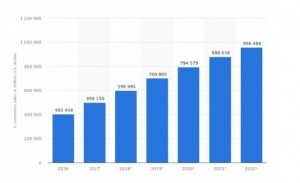Finland taps WeChat for entry into China’s cross-border e-commerce market

China boasts a strong and fast-growing e-commerce market, particularly in the food and beverage industry.
According to a 2018 report by market research firm Statista, its e-commerce market is the largest in the world, with online sales in B2C e-retail reaching US$499,150 billion (€440,951 billion) in 2018. E-commerce user penetration currently sits at 72.3% and is expected to hit 81% by 2023.
This is largely driven by mobile consumer behaviour, early adoption of new technologies, and China’s trusted digital payment systems.
“Food and beverage products ranked top three among all fast moving consumer goods (FMCG) products in e-commerce sales,” Fan Cuilu, senior advisor, China, e-commerce, at Business Finland, told FoodNavigator.
A surge in cross-border e-commerce
According to Cuilu, cross-border e-commerce – which enables international brands to market products without any physical presence or trademark license in China – offers easier access for food and beverage companies in terms of export compliance.
“Finnish food and beverage brands face many challenges to export to China through traditional trade, as well as many western food brands,” she explained.
“Therefore, to land in China and start to build a customer base, cross-border e-commerce is an important channel…definitely all European brands can benefit from these tech platforms.”
Cross-border e-commerce has grown strongly in recent years as the number of channels, payment methods and offerings have improved. There are mainly two operating models: direct shipping from overseas or the bonded warehouses model.
According to Business Finland, the renewal of e-commerce law will see private sales from overseas into China be regulated. However, this also presents an opportunity to industry: “It [will] allow more product categories to be sold legally through authorised cross-border e-commerce platforms or channels.
“This is also to implement [the] Chinese government’s goal of opening up the market and encouraging import and export into and from China.”
WeChat: The ‘gateway’ to reaching Chinese consumers
Food from Finland, a programme managed by Business Finland Oy, is harnessing cross-border technologies to facilitate Finnish food companies’ entry into China’s e-commerce market.
The programme is funded by both the Ministry of Economy and Employment and the Ministry of Agriculture and Forestry, and collaborates with the Finnish Food Authority, the Finnish Food and Drink Industries’ Federation (ETL) and private companies in the Finnish food sector.
Food from Finland plans to introduce Chinese online platforms including Tmall Global; JD.com; freshhema.com; and the popular multi-purpose messaging, social media and mobile payment app, WeChat, to Finnish food and beverage companies to increase export channels to China.
“Currently, Food from Finland hosts an official account on WeChat,” Cuilu told us. While still under construction, the pilot WeChat cross-border e-commerce store has the potential to help brands gain more attention from other e-commerce platform operators.
“WeChat and other Chinese tech platform are gateways for reaching Chinese consumers,” she explained.
“WeChat alone has over one billion active users spending more than four hours a day on it. Not to mention the impressive sales figure over the 11:11 ‘single day’ shopping festival on different tech platforms. Finish food and beverage companies can definitely benefit from its huge consumer base.”
Profile: The online shopper in China
The typical online shopper is 20-45 years of age. Women make the majority of online purchases in a family household.
95% of China’s internet users use their mobile device. Mobile e-commerce accounts of 71% of China’s total e-commerce.
The most popular payment options are Alipay and WeChat Pay. Together, they represent 92% of the mobile payment market share.
Looking abroad to ‘clean, safe and pure’ Finland
In China, growing demand has been observed in foreign FMCG brands, with biscuits, chocolate, instant noodles, chewing gum, candy, infant formula, milk, yoghurt, juice, beer, RTD tea, carbonated soft drinks and packaged water making up 80% of China’s FMCG purchases.
According to Business Finland, growing food safety concerns in China have contributed to this change in consumer behaviour.
“Other significant reasons include the increasing number of middle to high income Chinese looking for premium food selections, and increasing awareness of dietary health,” said Cuilu.
“Many high income Chinese also have experience travelling, living or working overseas,” she continued. “On returning to China, they bring back other food cultures.”
Enter, Finnish made food and beverages. Finland is proud of its voluntary animal health and welfare classification systems and its population is “passionate about pure and healthy food”, said Cuilu, adding that the Scandinavian country has expertise is catering to special diets, including gluten- and lactose-free regimes.
“Finland particularly [evokes] clean, safe and pure images [for] Chinese tourists and consumers,” she continued.
While Finnish food and beverage offerings may be less known to Chinese consumers than other European countries’, Cuilu argued that cross border e-commerce could be a cost-effective way for Finnish small- and medium-sized enterprises (SMEs) to test and sell their products on the Chinese market.
“Some of [China’s] tech platforms can reach to niche and targeted consumer markets, [and] hence, give better support for new brands to China.”























